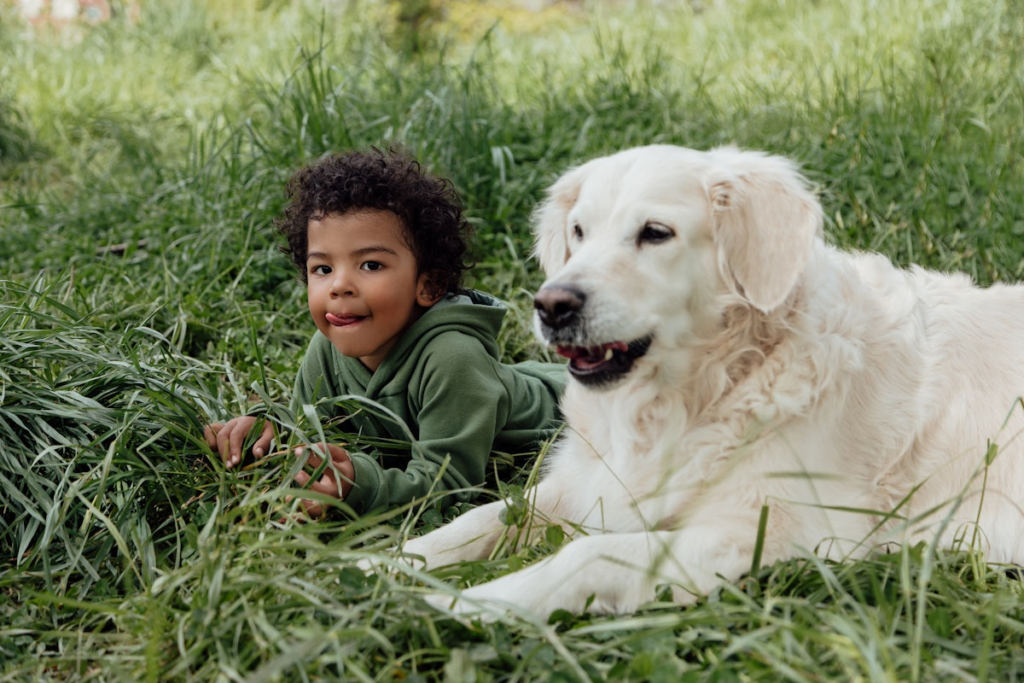Protection or behavior issue? A trainer’s take on dogs and babies.
Is it really "cute" or "special" when a pet dog guards a baby… or is it a sign of a bigger problem? It certainly seems like something you’d see in a sappy dog movie. But one dog trainer is weighing in on what we’re actually seeing when we witness a dog acting "protective" over a child — and, newsflash, it’s not a sign of a special bond between the pair. In fact, it could indicate resource guarding, a serious behavioral issue in the dog. That’s the message K-9 expert Jacqui Zakar (@DogSense) is trying to get across to parents in a series of explanatory videos on TikTok.
You’ve seen it before: Mom and Dad bring home a precious new babe. At first, Fido might seem unsure or even a bit sulky and jealous of the new baby in the family taking away the attention he got when he was a puppy. At some point, though, the pup’s disposition changes. They might be gentle and sweet with the new baby. Perhaps your precious pup "herds" the baby from the top of the steps or sleeps under their crib.
Other times, though, this bond can take on a different tone. A dog might become much more protective, growling at visitors or parents if they get too close to the baby. Some people think that’s cute, pointing to it as proof the dog loves the baby just as much as Mom and Dad do. Zakar says that’s not exactly the case.
Zakar recently shared a video uploaded by another user showing a dog lying beside a baby. As the child’s parent approaches, the dog growls. The caption on the video — “When the dog thinks he’s dad now” — points to the light-hearted way people typically view this type of behavior.
In response, Zakar explains, “On the one hand, we want our dogs to listen to us, to be obedient to follow our guidance. But, on the other hand, we see a video like this and we think the dog is being protective. This dog is aggressively warning its own owner to stay away from their own child. That’s not being obedient. That’s not listening. What reason does a dog have to guard a baby from its own parent? The reason is because this is a behavioral issue. It’s not protection. It’s nothing to do with the baby’s safety. Please. Can we wake up?”
You don’t have to be a dog trainer to see what she means. You might want your dog to protect you from scary outside dangers. However, your dog shouldn’t see you as a “threat.” And of course, you don’t want him keeping you from your own possessions or your own children.
Even if you wanted to argue against Zakar’s point that the dog isn’t trying to keep the baby safe, the behavior is still disconcerting. By the logic the dog is being “protective,” you could be playing rough-and-tumble with your toddler and your dog could attack you since they’d assume you were hurting your child. Not only are you in danger in that scenario, but your child is suddenly in danger, too.
Zakar’s opinion has obviously caused a bit of commotion. Since then, she’s addressed people’s concerns in a couple of videos. In one follow-up video, Zakar goes more in-depth on the behavior and warns parents that it’s very rarely a gradual change in a dog’s behavior, and you should watch for signs.
“You’re never going to know exactly why this kind of behavior shows up, but I can almost guarantee that it hasn’t been sudden. It’s usually a case of the lower level signs just haven’t been identified, or they’ve been misidentified as something else,” Zakar says. “As I’ve said previously, resource guarding usually has a genetic component. It wouldn’t be surprising if this dog was guarding other things. If the underlying emotion driving this behavior isn’t addressed, it will likely get worse.”
When Zakar talks about a dog guarding other things, she’s referring to resource guarding. This might look like a dog who snaps at you if you pet them while they’re drinking or who is protective over their own food bowl. Other signs include a dog stiffening its body over an item, “whale eye” (when the whites of their eyes show), lifting their lips, staring, low growling, and baring of the teeth.
The key takeaway here is to make sure that your dog is really trained properly and that you’re noticing any new or persistent behaviors. Not all behaviors might seem troublesome at the moment. But in the long term, they could spiral into much bigger issues — like a dog who won’t let parents near their own child, or a dog who bites a crawling babe when they reach into his food bowl. According to the Centers for Disease Control and Prevention, 4.5 million people are bitten by dogs annually, with 800,000 requiring medical attention — the most common victims being kids.
So, while it’s cute when dogs and kids have special bonds, it’s crucial to make sure that their relationship is healthy and safe.
If you are looking for a dog that’s safe to have around kids but will also protect the entire family, look at these dog breeds below. These types of pups make excellent pets and are also known for defending their households.
Dog Breeds That Aren’t Good for Families
This list is not, in any way, meant to give any dog breed a bad rap. However, traits in some dogs don’t always mesh well with children. Here are a few pups you should think twice about adopting and letting in your home if you have small children.
This article was originally published on

